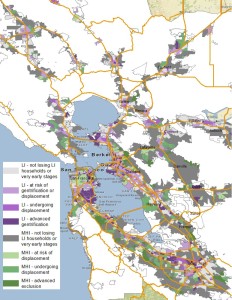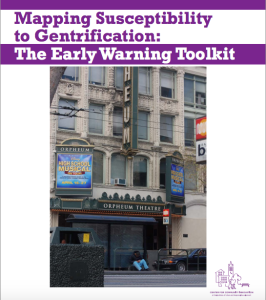Research Summary
Publications
News and Media
Blogs
Documents and Other Resources
 Research Summary
Research Summary
The Urban Displacement Project is a research and action initiative of UC Berkeley in collaboration with researchers at UCLA, community based organizations, regional planning agencies and the State of California’s Air Resources Board. The project aims to understand the nature of gentrification and displacement in the Bay Area. It focuses on creating tools to help communities identify the pressures surrounding them and take more effective action.
The Center for Community Innovation (CCI) at UC Berkeley conducted regional data analysis and nine neighborhood case studies to understand better the nature and drivers of gentrification and displacement. From this analysis, and with careful review and input from an advisory committee, CCI developed eight neighborhood typologies to help communities better characterize their experiences with gentrification and risks of displacement.
Literature Review on Gentrification
In 2015, researchers at UC Berkeley and UCLA completed a review of the academic and practitioner literature on gentrification, displacement and its relationship to public and private investments. This review provides summarizes research that has gone into the nature of neighborhood change and highlights many limitations in the literature.
Displacement Maps
As part of the Regional Early Warning System for Displacement project funded by the Metropolitan Transportation Commission, UC Berkeley conducted regional data analysis to better understand the nature and drivers of gentrification and displacement, which was validated through 9 neighborhood case studies. From this analysis, and with careful review and input from an advisory committee, we developed 8 neighborhood typologies to help communities better characterize their experience and risks in an effort to raise awareness and stimulate action. Explore the links below for more information on the typologies and the methodology used to develop them.
Online interactive maps
Methodology and results of the Regional Early Warning System for displacement
Susceptibility Report
In 2009, we developed an early warning toolkit for gentrification with funding from the Association of Bay Area Governments. View our early warning gentrification report
Case Studies in the Bay Area
The Urban Displacement Project is grounded in live experiences of real communities. This is why our research analyzed 9 different case studies from across the Bay Area. Beginning in the spring of 2014, UC researchers partnered with 7 community-based organizations funded by MTC’s Regional Prosperity Plan to complete a comprehensive neighborhood profile based on data analysis, stakeholder interviews and ground-truthing of data.
Browse our online case studies and explore our interactive maps for more information.
Policy Tools
In the summer of 2014, we inventoried 10 anti-displacement policies and strategies in the Bay Area and complemented the inventory with a survey conducted by the Association of Bay Area Governments to better understand the anti-displacement landscape in the Bay.
View our displacement policy map and our displacement prevention policy tools
Publications
Goetz, Edward G. & Chapple, Karen 2010. “You Gotta Move: Advancing the Debate on the Record of Dispersal.” Housing Policy Debate 20(2).
Chapple, Karen. 2006. “Overcoming Mismatch: Beyond Dispersal, Mobility, and Development Strategies.” Journal of the American Planning Association 72(3): 322-336.
Chapple, Karen, John V. Thomas, Dena Belzer,, & Gerald Autler. 2004. “Fueling the Fire: Information Technology and Housing Price Appreciation in the San Francisco Bay Area and the Twin Cities.” Housing Policy Debate 15(2): 347-383.
Goetz, Edward G., Karen Chapple, & Barbara Lukermann. 2004. “The Minnesota Land Use Planning Act and the Promotion of Low- and Moderate-Income Housing in Suburbia.” Law and Inequality: A Journal of Theory and Practice 22(1): 31-72.
Goetz, Edward G., Karen Chapple, & Barbara Lukermann. 2003.“Enabling Exclusion: The Retreat from Regional Fair Share Housing in the Implementation of the Minnesota Land Use Planning Act.” Journal of Planning Education and Research 22(3): 213-25, 2003.
Chapple, Karen. 2009. Mapping Susceptibility to Gentrification: The Early Warning Toolkit . Berkeley, CA: Center for Community Innovation.
Reconnecting America, Center for Community Innovation, and Non-Profit Housing Association of Northern California.2007. Transit-Oriented for All: The Case for Mixed-Income Transit-Oriented Communities in the Bay Area. Berkeley, CA: Center for Community Innovation..
Goetz, Edward G., Karen Chapple, and Barbara Lukermann. 2002. “The Affordable Housing Legacy of the 1976 Land Use Planning Act.” Center for Urban and Regional Affairs, University of Minnesota, 2002.
Chapple, Karen. 2012. “Evaluating the Effects of Projected Job Growth on Housing Demand.” Report prepared for the Association of Bay Area Governments.
Chapple, Karen and Strategic Economics. 1999. “Gentrification: Causes, Indicators, and Possible Policy Responses for the San Francisco Bay Area.” Report prepared for Urban Habitat.
Goetz, Edward G., Karen Chapple, and Barbara Lukermann. 2005. “The Rise and Fall of Fair Share Housing: Lessons from the Twin Cities.” In Xavier de Souza Briggs, ed., The Geography of Opportunity: Race and Housing Choice in Metropolitan America. Washington, DC: Brookings Institution Press.
Chapple, Karen. 2002. “Sharing America’s Neighborhoods: The Prospects for Stable Racial Integration, by Ingrid Gould Ellen.” Book review. Journal of Planning Education and Research 22(2).
News and Media
NextCity
August 25, 2015- New Map Tool Can Serve as Gentrification Warning System
KGO News
August 25, 2015- Cal Study Shows Danger in Expanding Public Transit
Berkeley News
August 24, 2015- More gentrification, displacement in Bay Area forecast
San Jose Mercury News
April 12, 2015- A new call for rent control
KQED Forum with Michael Krasny
What’s the Best Way to Boost Affordable Housing?
November 25, 2013
http://www.kqed.org/a/forum/R201311251000
Blog Posts
The Future of Displacement
The Blocked Market for Density and Affordable Housing
Other Documents and Resources
This report was prepared for ABAG as part of its Development without Displacement project funded by an environmental justice grant from CalTrans. This project is meant to increase regional and local understanding of gentrification and displacement, and in particular increase awareness of equitable development policies that jurisdictions can use to capture the benefits of new growth for their current residents. The purpose of this report is to create an early warning toolkit to help communities identify whether their neighborhood is susceptible to gentrification as reinvestment occurs. This in turn suggests potential for displacement — but does not necessarily predict it. In order to understand future displacement potential more fully, a jurisdiction would need to combine the toolkit with an assessment of its existing affordable housing policies and stock, as well as the effects of any proposed redevelopment plan.
For more definitions, publications, courses, links to policy and advocacy organizations and tenants’ rights organizations, and links to related research, explore the resources on the Urban Displacement website.
